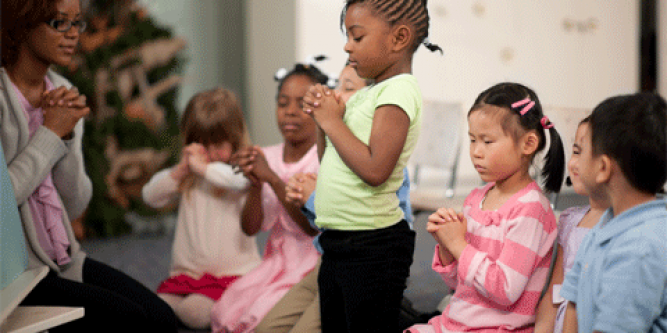A Glimpse of Children in the Biblical Story
The Book of Deuteronomy instructs God’s people to teach children to love, obey, and fear the Lord God in the context of life. Children are to assemble with adults to learn the things of God (Deuteronomy 6:1–3, 11:18–21, 31:12–13).
Other Old Testament passages describe how children were present with the whole faith community as they stood to hear from God, to weep before God, and to celebrate together (2 Chronicles 20:13; Ezra 10:1; Nehemiah 12:43).
In the New Testament, Jesus’ interactions with and His words about children are especially helpful. In Matthew 11:25–26, Jesus was praying and acknowledged that things are revealed to children which sometimes are hidden from those who are wise. Another time He used children as the model for entering the kingdom of heaven (Matt 18:2–3). After Jesus’ triumphal entry into Jerusalem, He entered the temple, overthrew the tables of the moneychangers, and then healed those in need. The children acknowledged who Jesus was by shouting, “Hosanna to the Son of David,” while the religious leaders and teachers simply became angry (Matt 21:12–16).
An especially significant incident with children is recorded in the Gospel of Mark. People were bringing their children to Jesus, but the disciples tried to keep them from doing so. This made Jesus angry (the text uses the word “indignant”). Jesus told the disciples to stop interfering and let the children come to Him. That public gesture was atypical for a Jewish male of that day; Jesus took the children in His arms and blessed them (Mark 10:13–16).
From these few passages it is evident that children occupied an important place within the people of God. Being among God’s people was significant for the spiritual formation and nurture of those children. Jesus Himself viewed children highly by welcoming them and, significantly, by telling the adults to become like them for their own spiritual health. In a way, the text is saying that it is not truly a faith community if the children are not present.
Contemporary Scholars’ Perspectives on Children’s Spiritual Formation
In the past 20 years, considerable scholarly work has focused on the spiritual formation and spirituality of children. (*See below for resource ideas.) Common themes in these works include the incredible capacity that children—even young children—possess to experience and reflect on God. These scholars emphasize the formative value for adults and children alike to worship together and the significance for intergenerational participation in God’s story while also hearing each other’s stories. They also point out the importance of equipping parents for the powerful, unique role that they have in the spiritual formation of their children.
Perspectives on Children
Ivy Beckwith, an experienced pastor of children, in the introduction to her book Postmodern Children’s Ministry: Ministry to Children in the 21st Century (2004, p. 13–14), vividly describes her perspective on the current state of children’s ministry as broken. She views it as broken when church leaders and senior pastors see children’s ministry primarily as a marketing tool; when the most outwardly attractive program is assumed to be the most effective; when God is trivialized. “And perhaps most importantly, it’s broken when the church tells parents that its programs can spiritually nurture their children better than they can…A church program can’t spiritually form a child, but a family living in an intergenerational community of faith can” (p. 14).
Supportive of Beckwith’s position, Carla Barnhill (2007), an author and overseer of children’s ministry, writes, “Rather than seeing children as somehow unfinished and unable to participate in the life of the church until they have learned something, we can encourage children to contribute to the community” (p. 56). Many churches view children as inherently capable in age-appropriate ways of loving the Lord Jesus and wanting to be obedient to His teachings out of their love for Him. Therefore, they see their ministries as an open system of nurture in which the children have dozens of “relatives”—surrogate parents, grandparents, aunts, uncles, and cousins— who get to know, love, and “co-parent” them. Barnhill feels multigenerational ministry is foundational in a child’s spiritual formation.
The following sources, among many others, are helpful in this regard:
- Real Kids, Real Faith: Practices for Nurturing Children’s Spiritual Lives (2004) by Karen Marie Yust
- Will Our Children Have Faith? (2000) by John Westerhoff
- Joining Children on the Spiritual Journey (1998) by Cathy Stonehouse
- Godly Play: An Imaginative Approach to Religious Education (1995) by Jerome Berryman
- The Religious Potential of the Child (1992) by Sofia Cavalletti
- The Spiritual Life of Children (1990) by Robert Coles.
Download Complete Article Here (PDF)
__
__
About The Authors:
Scottie May (Ph.D., Trinity Evangelical Divinity School, Deerfield, IL) serves as Associate Professor of Christian Formation and Ministry at Wheaton College, Wheaton, IL.
E-mail: Scottie.may@wheaton.edu.
Children’s Place in the New Forms of Church: An Exploratory Survey of Ministry with Children and Families is taken from the Christian Education Journal, CEJ: Series 3, Vol. 8, No. 2. Copyright 2011; p 278-305. All rights reserved. Permission granted by Christian Education Journal.
Want to share this article outside of your ministry? Want to post this electronically? Please contact Dr. Kevin Lawson, Editor for permission Editor.cej@biola.edu.
Subscribe to Christian Education Journal: cej.subscriptions@biola.edu









Loved this!! Whole-heartedly agree! Thanks for posting this article!